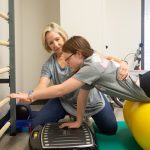Understanding the Vestibular System


Even though the mechanics of the vestibular system are very basic, they are complex to fully comprehend. Understanding the vestibular system is crucial to understanding the types of difficulties children may have. It’s equally important to understand as we move to address these problems.
The human eyes and ears receive sights and sounds which then send that information to our brain. Movement and change of direction (semi-circular canals) and the change of head position and gravitational pull (otoliths) give us an important functioning ability to coordinate our eye and head movements. This function is used in our everyday lives – from watching a sports game to reading a book. Studies conclude that half of the children with learning disorders show signs of vestibular inefficiencies.
Another important feature of the vestibular system is helping us develop and maintain muscle tone. While muscle tone is not the same as muscle strength, it does allow us to hold our body in position and maintain upright positions. In children, it’s especially important to help keep their heads up. Children with vestibular problems may slouch at their desks, prop their heads up with their hands, or have low endurance. Vestibular problems can also affect balance and equilibrium, the ability to coordinate both sides of the body, and sometimes include aspects of language.
A vestibular difficulty can affect basic but important functions of our everyday lives. These obstacles are often invisible and overlooked. Children require a great deal of movement in early development to support the vestibular sense and the many functions it pertains to. However, as children grow older and this system matures, there is often an emphasis on less movement, such as a teacher telling a student to “sit still.” This may not benefit the child who needs more input for their vestibular system to function efficiently. Ultimately, adults need to understand the complexity of the vestibular system and the role it plays in child development.
Help the Vestibular System Develop and Function Well:
Make Time for Movement Experiences
Experiences that require movement are important to a developing child. Activities that require movement such as swinging, sliding, or riding a merry-go-round are a great way to encourage movement.
Promote Intentional Movement
Prioritize child-propelled movement rather than passive movement actions. Passive movements such as spinning, twirling, or swinging a child excessively or for prescribed lengths of time are discouraged.
Encourage Effective Activities
Activities where the child lies on their stomach and holds their head up are great for development. Place building blocks or other toys in front of the child for play or try having them throw objects at a target while they are on their stomach.
Promote Bilateral Activities
Two-sided activities such as jumping rope, riding a bike, or swimming can help the vestibular system progress.
Take Mental Notes
Watch cues that your child gives – see if it’s easier to sit up or do table work after trying movement activities, especially activities that require the head to move in different directions. Activation of the vestibular system often has an immediate effect on the child’s nervous system which can help aid in the progression of desktop activities.
Adapted From: THE VESTIBULAR SYSTEM: WHY IS IT SO CRITICAL?© is part of a series of “Parent Pages” on the topic of sensory integration written by Zoe Mailloux, OTD, OTR/L, FAOTA. www.cl-asi.org




